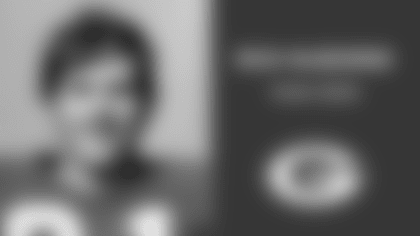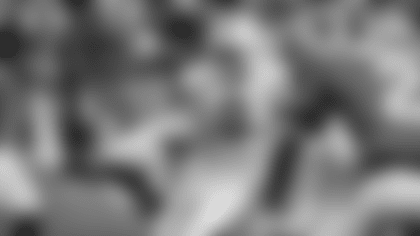Like all rookies now headed into their second year in the NFL, defensive end Jeremy Thompson should significantly benefit from the Packers' offseason strength and conditioning program when it begins in mid-March.
But in Thompson's case, it's not so much the "strength" part he'll be working on. It's the "size."
Thompson will be the first to admit he needs to get bigger to be a regular player at his position in the NFL. He said when he came to Green Bay he was around 260 or 265 pounds, but as the season went on he said he dropped as low as 255.
That's just not big enough to bang play after play against NFL offensive tackles, despite his impressive physique and well-conditioned muscles. Thompson was limited to 178 snaps during his rookie season due to a couple of injuries, but if he wants to play more than that, and play effectively, in his second year, he needs to fill out his 6-foot-4 frame a little more.
"If you look at him, if you look at his shell, he could gain more weight," defensive ends coach Carl Hairston said. "It's not like he's not strong. He's pretty strong, but he needs the bulk to rush the passer and play every down."
This past season was a bit of a lesson for Thompson in what a full training camp and 16-game season can do to a young body, as opposed to the 11- or 12-game slate in the college ranks.
He arrived in Green Bay having spent his offseason training for the Senior Bowl and then for the NFL scouting combine, so his body never really got a break. Now, he'll be able to take advantage of a month or two off, heal up his injuries, and then focus on specific training goals that he'll set with his position coaches and strength and conditioning coaches.
"You really have to eat right all the time, work out, make sure you're staying on top of your workouts," he said. "I'm looking to get my weight back up around 270 and keep my speed."
And therein lies the rub. Thompson knows he'll have to be careful not to add the size he wants at the expense of his other attributes.
Hairston has spoken often about his speed and agility for a defensive end, which could make him a viable pass rusher with some seasoning. So whether or not 270 becomes the ultimate target remains to be seen, but the goal will be finding the right size at which he can defend the run and rush the passer equally well.
"It would be great to see him at that weight because you'd have the bulk you need, but in the end he might lose something else," Hairston said. "We don't want him to lose what he's got. We want him to build on what he has."
Thompson started to do that around mid-season before some injuries got in the way.
He was active for the first time in Week 5, taking over for an injured Michael Montgomery, and he saw even more action the next week at Seattle. There, he held his own against Pro Bowl left tackle Walter Jones and even got into the backfield to bring down fullback Leonard Weaver for a 3-yard loss.
The following week he started his first NFL game, against Indianapolis, and continued his effective play with a season-best five tackles. But after two more starts, a groin injury forced him to miss two games.
Then upon his return, against Carolina in Week 13, he sustained ankle and knee injuries that kept him out for another game. He then played the final three games on an ankle that was less than 100 percent and had very little impact down the stretch, though he did produce some quality pass rush in the finale against Detroit, which Hairston felt was good to see.
{sportsad300}"When you've got a pass rusher with a 36-, 37-inch reach, you can do a lot with that," Hairston said. "I tell him to just start reaching for people, there's no telling what you'll grab. I like his speed, I like his athletic ability."
It's hard for Thompson to lament the injuries, because had it not been for Cullen Jenkins, Kabeer Gbaja-Biamila and Montgomery battling their own ailments, he may have gotten no more than a "redshirt" first season.
But there's no doubt the injuries hindered his progress in the second half of the season, which makes his first offseason program all the more important.
"That's the problem, he didn't get a full year," Hairston said. "He'd get banged up and miss two weeks here, a week there. It hurts you as far as maturing, but hopefully he can get past that next season."
Hairston does not think Thompson's injuries, despite limited playing time, are a red flag that his body won't hold up through the rigors of an NFL season. Though he does need to get bigger, his injuries weren't a direct result of being too small for the position.
"The ones that he had, the ankle and groin, that's going to happen in the NFL," Hairston said. "As far as the groin, maybe there's something to do in the weight room or flexibility-wise (to prevent future problems). But ankles, you never know when it's going to happen. As a pass rusher with a bad ankle, it's going to hurt you.
"But I think by the time he comes back for the offseason he should be pretty healthy. I think he'll be OK. He just has to learn from this season."
Thompson believes he has, both on and off the field.
"Other players' injuries gave me an opportunity to step in there and the more I was in there, the more I improved," he said. "The speed of the game, you really have to be in tune with that, and prepare every week like it's the last game of the season.
"I just have to stay in the weight room, eat healthy, get healthy, and keep working hard."
"Adding" to what he's already got.
"His strength is not in question," Hairston said. "Sometimes you just need more bulk. That's something that is going to come with a strong offseason training program, and I think he's prepared for that."














